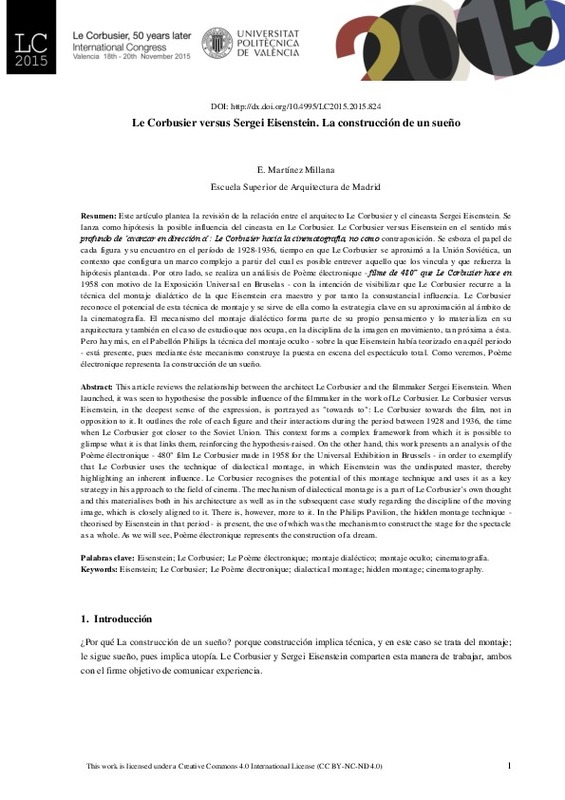JavaScript is disabled for your browser. Some features of this site may not work without it.
Buscar en RiuNet
Listar
Mi cuenta
Estadísticas
Ayuda RiuNet
Admin. UPV
Le Corbusier versus Sergei Eisenstein. La construcción de un sueño
Mostrar el registro sencillo del ítem
Ficheros en el ítem
| dc.contributor.author | Martínez Millana, Elena
|
es_ES |
| dc.date.accessioned | 2017-09-13T06:38:10Z | |
| dc.date.available | 2017-09-13T06:38:10Z | |
| dc.date.issued | 2016-03-03 | |
| dc.identifier.isbn | 9788490483732 | |
| dc.identifier.uri | http://hdl.handle.net/10251/87137 | |
| dc.description.abstract | [EN] This article reviews the relationship between the architect Le Corbusier and the filmmaker Sergei Eisenstein. When launched, it was seen to hypothesise the possible influence of the filmmaker in the work of Le Corbusier. Le Corbusier versus Eisenstein, in the deepest sense of the expression, is portrayed as "towards to": Le Corbusier towards the film, not in opposition to it. It outlines the role of each figure and their interactions during the period between 1928 and 1936, the time when Le Corbusier got closer to the Soviet Union. This context forms a complex framework from which it is possible to glimpse what it is that links them, reinforcing the hypothesis-raised. On the other hand, this work presents an analysis of the Poème électronique - 480" film Le Corbusier made in 1958 for the Universal Exhibition in Brussels - in order to exemplify that Le Corbusier uses the technique of dialectical montage, in which Eisenstein was the undisputed master, thereby highlighting an inherent influence. Le Corbusier recognises the potential of this montage technique and uses it as a key strategy in his approach to the field of cinema. The mechanism of dialectical montage is a part of Le Corbusier's own thought and this materialises both in his architecture as well as in the subsequent case study regarding the discipline of the moving image, which is closely aligned to it. There is, however, more to it. In the Philips Pavilion, the hidden montage technique - theorised by Eisenstein in that period - is present, the use of which was the mechanism to construct the stage for the spectacle as a whole. As we will see, Poème électronique represents the construction of a dream. | es_ES |
| dc.description.abstract | [ES] Este artículo plantea la revisión de la relación entre el arquitecto Le Corbusier y el cineasta Sergei Eisenstein. Se lanza como hipótesis la posible influencia del cineasta en Le Corbusier. Le Corbusier versus Eisenstein en el sentido más profundo de ‘avanzar en dirección a’: Le Corbusier hacia la cinematografía, no como contraposición. Se esboza el papel de cada figura y su encuentro en el período de 1928-1936, tiempo en que Le Corbusier se aproximó a la Unión Soviética, un contexto que configura un marco complejo a partir del cual es posible entrever aquello que los vincula y que refuerza la hipótesis planteada. Por otro lado, se realiza un análisis de Poème électronique - filme de 480” que Le Corbusier hace en 1958 con motivo de la Exposición Universal en Bruselas - con la intención de visibilizar que Le Corbusier recurre a la técnica del montaje dialéctico de la que Eisenstein era maestro y por tanto la consustancial influencia. Le Corbusier reconoce el potencial de esta técnica de montaje y se sirve de ella como la estrategia clave en su aproximación al ámbito de la cinematografía. El mecanismo del montaje dialéctico forma parte de su propio pensamiento y lo materializa en su arquitectura y también en el caso de estudio que nos ocupa, en la disciplina de la imagen en movimiento, tan próxima a ésta. Pero hay más, en el Pabellón Philips la técnica del montaje oculto - sobre la que Eisenstein había teorizado en aquél periodo - está presente, pues mediante éste mecanismo construye la puesta en escena del espectáculo total. Como veremos, Poème électronique representa la construcción de un sueño. | es_ES |
| dc.format.extent | 19 | es_ES |
| dc.language | Español | es_ES |
| dc.publisher | Editorial Universitat Politècnica de València | es_ES |
| dc.relation.ispartof | LE CORBUSIER. 50 AÑOS DESPUÉS | es_ES |
| dc.rights | Reconocimiento - No comercial - Sin obra derivada (by-nc-nd) | es_ES |
| dc.subject | architecture | es_ES |
| dc.subject | le corbusier | es_ES |
| dc.subject | modern movement | es_ES |
| dc.title | Le Corbusier versus Sergei Eisenstein. La construcción de un sueño | es_ES |
| dc.type | Capítulo de libro | es_ES |
| dc.type | Comunicación en congreso | es_ES |
| dc.identifier.doi | 10.4995/LC2015.2015.824 | |
| dc.rights.accessRights | Abierto | es_ES |
| dc.description.bibliographicCitation | Martínez Millana, E. (2016). Le Corbusier versus Sergei Eisenstein. La construcción de un sueño. En LE CORBUSIER. 50 AÑOS DESPUÉS. Editorial Universitat Politècnica de València. 1393-1415. https://doi.org/10.4995/LC2015.2015.824 | es_ES |
| dc.description.accrualMethod | OCS | es_ES |
| dc.relation.conferencename | LC2015 - Le Corbusier, 50 years later | es_ES |
| dc.relation.conferencedate | November 18-20,2015 | es_ES |
| dc.relation.conferenceplace | Valencia, Spain | es_ES |
| dc.relation.publisherversion | http://ocs.editorial.upv.es/index.php/LC2015/LC2015/paper/view/824 | es_ES |
| dc.description.upvformatpinicio | 1393 | es_ES |
| dc.description.upvformatpfin | 1415 | es_ES |
| dc.type.version | info:eu-repo/semantics/publishedVersion | es_ES |
| dc.relation.pasarela | OCS\824 | es_ES |








